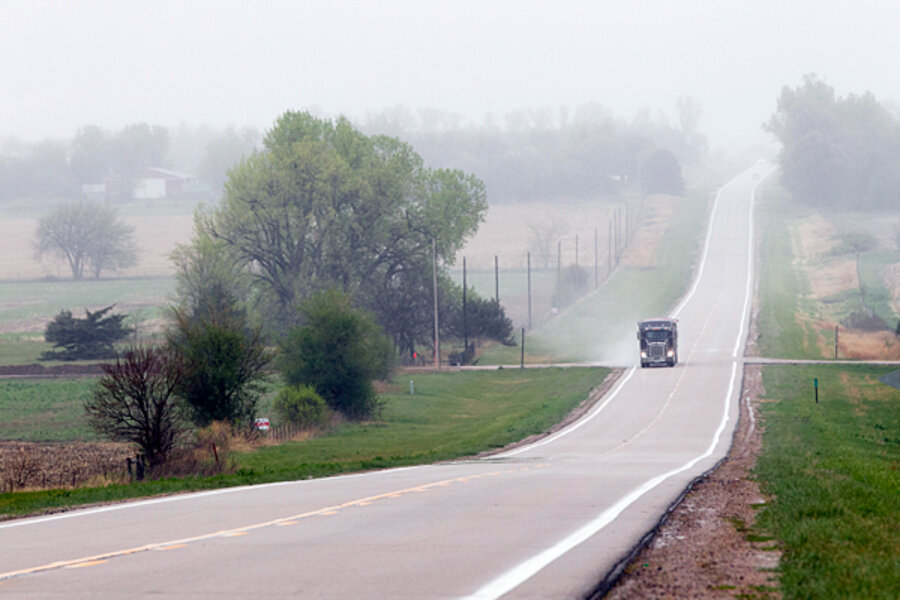Keystone XL pipeline: Nebraska officials get tough on TransCanada
The newly proposed northern route for the Keystone XL pipeline that snakes down from Canada through Nebraska – trying to avoid its environmentally fragile Sand Hills region and fresh-water aquifers – is coming in for tough new scrutiny that could ignite a fresh political and environmental fracas.
Under intense pressure to show they are not doormats for a foreign corporation, Nebraska's top environmental regulators are pressing Toronto-based pipeline company TransCanada for sensitive details, including the specific chemicals used to dilute the heavy tar sands bitumen that the 1,100-mile pipeline would carry from Canada to Nebraska. A southern leg would then take the bitumen onward to refineries in Texas.
In its 68-page "feedback report" response to TransCanada's proposed route from Alberta to Nebraska, the state's Department of Environmental Quality (DEQ) is calling for a raft of so-far undisclosed data that the company has said in the past is proprietary competitive information.
"What are the characteristics of the products being transported? What chemicals will be added to facilitate movement through the pipeline," the feedback report asks. "How toxic are the products being moved through the pipeline?"
Other questions also appear aimed at determining what impact the chemicals in the diluted bitumen would have if the pipeline leaks. There is high concern that in case of a spill, the diluted bitumen would, far more quickly than common crude oil, sink quickly into the porous soil along the route and contaminate the state's vital groundwater aquifer.
"Will emergency responders receive specific training to diagnose and treat exposures to dilutants and other chemicals in the oil?" the report continues. "Are any of the dilutants that are added to the crude oil water-soluble? How would these chemicals be removed from groundwater in the event of a spill or leak?"
Jane Kleeb, leader of Bold Nebraska, a state group opposing the pipeline, told local news media she was "thrilled" Nebraska's DEQ was asking tougher questions. The state's report shows the "pipeline route is still too risky for sandy soil and thin aquifers," she wrote in her blog Wednesday. "The NE DEQ states they hope TransCanada will move the pipeline route to avoid these areas."
Indeed, the DEQ report does urge TransCanada to “consider route variations” inside the 2,000-foot wide corridor it has laid out – and where that could not be done, provide reasons why not.
"This feedback will help us address the public’s questions before a new route is finalized," Shawn Howard, a TransCanada spokesman, said in a statement e-mailed to the Monitor. "We want to make sure that we understand any guidance or direction NDEQ has now provided, and we look forward to discussing this with them in greater detail in the coming days."
Meanwhile, in a letter Tuesday to Secretary of State Hillary Rodham Clinton, climate scientists urged that the State Department evaluate the pipeline not only on its local environmental impacts – but on its impact on global climate change. President Obama earlier this year deferred a quick decision on the pipeline demanded by congressional backers of the project in favor of a more thorough review.
"We are writing to ask that the State Department conduct, as part of its evaluation of the Keystone XL pipeline proposal, a serious review of the effect of helping open Canada’s tar sands on the planet’s climate," said the letter signed by 10 leading climate scientists, including Michael Mann, a researcher with Penn State University, and James Hansen, a researcher at Columbia University.
"At the moment, your department is planning to consider the effects of the pipeline on ‘recreation,’ ‘visual resources,’ and ‘noise,’ among other factors,” the scientists' letter continues. "Those are important – but omitting climate change from the considerations is neither wise nor credible."
The vast volumes of carbon in the tar sands "ensure that they will play an important role in whether or not climate change gets out of hand," the letter concludes. "Understanding the role this large scale new pipeline will play in that process is clearly crucial."





